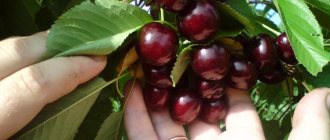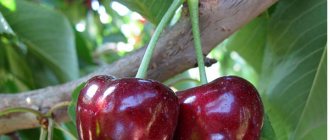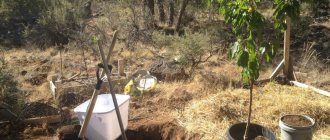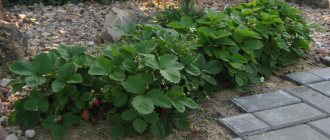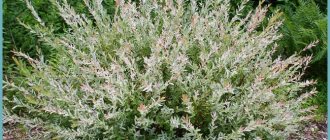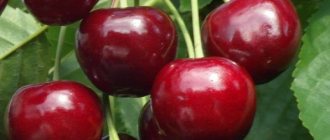Description of cherries Gift to Stepanov
The variety belongs to the category of medium-growing: the maximum height of the tree is 3.5 m. The shoots of the cherry are straight, thickened, covered with brown-gray bark with a slight olive tint at the edges. After the autumn leaves fall, the bark acquires a pronounced silvery tint.
The natural shape of the crown is pyramidal; the upper branches of the tree grow quite quickly. The leaves are matte green, large, with sharp teeth along the edges, and the white flowers are presented in inflorescences of 3 flowers each.
The variety bears medium-sized heart-shaped berries with rounded outlines. As a rule, cherries are dark red, the skin is dense, tender and glossy. The average weight of one berry is 4–5 g - not very large fruits. The berries taste sweet, their tasting value is very high - 4.9 points out of a possible 5.
In the State Register, the variety is noted as suitable for cultivation in the Central region. But Gift to Stepanov also grows well in the Urals, where it easily tolerates harsh climatic conditions.
Description of the variety and its characteristics
The cherry variety Gift to Stepanov was born quite recently, at the beginning of this century, and was included in the State Register of our country even later, in 2015. However, despite this fact, this type of beloved garden berry has already won the recognition of gardeners and gardeners. It was obtained in the Bryansk region by the scientist-breeder A. Kanshina, whose goal was to obtain a variety of cherries that, with other numerous advantages, could easily withstand harsh winters.
Description of the tree
Trees of the variety are characterized by a high growth rate and early fruiting:
- they are of medium size, growing up to only 3.5 meters in height;
- branches and shoots of trees, strong and powerful, covered with brown bark with an olive tint, form a beautiful spreading crown, shaped like a pyramid;
- a few dark green matte leaves of large size and shaped like a boat. The edges of the leaves are carved, the tips are pointed;
- small five-petaled white flowers form inflorescences of three;
- The trees begin to bloom closer to mid-May. Flowering lasts a little more than a week;
- trees of the variety need additional pollination, which is provided by planting pollinating varieties next to them - Lyubimitsa Astakhova, Bryanskaya Rozovaya or Teremoshka;
- The variety begins to bear fruit 4 years after planting the seedlings.
Description of fruits
Berries of the Podarok Stepanov variety are truly a real gift:
- they are all the same and even, as if chosen. Size - medium, berry weight - about 6 g;
- the shape of the fruit is round, resembling a heart;
- color - rich dark red;
- tender juicy blood-red pulp is covered with the same delicate and thin glossy skin;
- inside the berries there are small seeds that are easily separated;
- the taste is harmonious, very sweet, without any aftertaste.
100 g of fruit pulp contains:
- sugars - about 13%;
- acids - 0.5%;
- ascorbic acid - about 14%;
- dry ingredients - 19%.
The taste of the berries of the Podarok Stepanov variety is rated very highly - on a five-point scale, 4.9 points.
Usage
The berries of this variety are very good fresh. Their rich chemical composition allows them to be used in dietary and baby food, as well as in folk medicine. Delicious jams and juices are made from these fruits, they are frozen, and added to baked goods, desserts and fruit salads.
Ripening and harvesting dates
Mass ripening of fruits occurs in mid-late July. Then they begin to harvest. The variety is characterized by the fact that if the fruits are not picked on time, they will remain on the branches for some time without falling off.
Productivity
The variety produces high yields. From a tree aged 5 or more years, about 60 kg are collected, and from 1 hectare - about 80 centners of juicy sweet berries.
Fruit shelf life and transportability
The berries of this variety are not stored for a long time due to the fact that their skin is too thin, therefore, immediately after harvesting, they must be immediately processed. Fruits are practically subject to transportation over long distances, as they quickly lose their presentation and taste, however, with high-quality packaging this is still possible.
Characteristics of the variety
Not much is known about the young Bryansk cherry variety: most gardeners who planted it on their plots have not yet had time to wait for the first harvest. However, some information is still available.
Drought resistance, frost resistance
Like most Bryansk varieties, the Podarok Stepanov cherry, bred for cultivation in the middle zone, nevertheless has high resistance to a more severe climate.
- The variety tolerates drought well; excess moisture is much more dangerous for it. During summer periods with minimal precipitation, it is recommended to water the cherries weekly in the amount of 3-4 buckets under the trunk; it is advisable to mulch the top layer of soil. If there is natural moisture, watering should be done only when necessary. If the tree receives enough moisture from rain, there is no need to water it additionally.
- The variety has high resistance to low temperatures: the tree retains the ability to bear fruit well even in conditions of -30...-32 degrees in winter. The main thing is to prevent deep freezing of the trunk.
Cherry pollinators Gift to Stepanov
The variety is not capable of self-pollination, and if you do not plant suitable pollinating varieties next to the cherry, you may not expect a rich harvest.
The following varieties of cherries are ideal as pollinators for trees:
- Teremoshka - cherry blossoms in the middle period, approximately May 10–15, and its fruits are harvested in mid-July.
- Astakhov’s favorite - the variety blooms in mid-May, and begins to bear fruit abundantly after 2 months, in mid-July.
- Bryansk pink - the tree usually blooms at the end of May, from the 15th to the 25th, berries appear on its branches at the end of July.
Important! On the listed pollinators, color appears at the same time as Gift to Stepanov. If you place them close to the seedling, this guarantees a large and high-quality harvest.
Productivity and fruiting
The variety brings quite high yields: up to 82 centners of fruit can be harvested from one hectare, and in a home garden the tree will produce up to 60 kg of berries. Cherries reach maturity by 4 years, in other words, only this period after planting can the first harvest be expected. But subsequently the cherry will bear fruit annually.
Fruiting occurs at the end of July - after the 20th.
Area of application of berries
The berries of this variety have a pleasant sweet taste, the pulp is easily separated from the seed. You can consume the fruits at your own discretion fresh or prepare healthy drinks from them, add berries to baked goods and homemade sweet desserts.
Resistance to diseases and pests
Cherry trees get sick very rarely: they have a high level of resistance to pests and fungal infections. At the same time, scab and cancer, white, brown and gray rot, powdery mildew and rust remain dangerous for the variety.
Attention! If any symptoms of disease appear on the bark or foliage of a tree, it must be treated with protective chemical compounds and all damaged parts are removed.
Cherry fruits can be damaged by cherry flies, aphids and weevils. When they appear, it is also necessary to carry out urgent sanitary treatment with special means.
Advantages and disadvantages of the variety
From the point of view of gardeners, the Podarok Stepanov variety certainly has more positive qualities than negative ones.
The advantages include:
- high level of resistance to harsh climates: the tree tolerates frost and lack of water;
- abundant harvests and dessert taste of fruits;
- good immunity to diseases dangerous to fruit trees and garden insect pests.
There are three main disadvantages of cherries.
- The variety is self-sterile, so it makes no sense to plant a tree in the neighborhood without pollinators: Podarok will not yield a harvest for Stepanov.
- The first berries appear on the branches of the tree no earlier than the 4th year of life.
- The size of the cherry fruits is not very large, their mass is quite small.
Planting rules and care
The growth and fruiting of the variety directly depends on the planting of seedlings and compliance with planting rules.
So, it is recommended to pay attention to such aspects.
| Selection of seedlings | It is recommended to give preference to trees from one to three years old. When purchasing, it is recommended to carefully examine the seedling; there should be no signs of damage or rot on it. |
| Disembarkation time | May vary depending on climate. In the southern regions, it is recommended to plant in the fall, before frost. In the northern territories - in the spring, immediately after the snow melts |
| Site selection | It is recommended to give preference to southern or western, well-lit areas of the garden. In this case, the distance from other trees should not be less than five meters |
| Well preparation | It should be dug up a month before planting. Before planting directly, it is recommended to fill its bottom with a mixture of fertile soil, potassium salt (90 g), compost, superphosphate (180 g) |
| Direct landing | After the soil settles, you need to place the seedling in the hole and cover it with soil. |
After planting, you should not relax, because care plays a significant role in the process of tree growth and development.
It is worth paying special attention to the following points.
- Crown trimming - a properly formed crown is the key to a good harvest. It is better to carry out the procedure during the transitional season, after a slowdown or before the start of sap flow. It is recommended to start pruning after the tree has grown to a height of up to 50 cm. When pruning an adult tree, it is recommended to maintain a height of no more than three and a half meters;
- Fertilizing - after two years of age, it is recommended to start applying fertilizer twice a day, every season. It is recommended to prepare it early in the morning (infusion of slurry mixed with a tablespoon of complex mineral fertilizer);
- Watering - it is recommended to pour 2 liters of liquid under a young seedling, increasing this amount by one and a half liters every year. It is worth producing poly at the beginning of flowering, before the formation of fruits and when preparing the tree for the period of winter dormancy;
- Loosening the soil - one of the most important aspects of care is the systematic weeding of the soil near the trunk. On chernozem, six loosenings are enough; on clay soil, it is recommended to increase the frequency of loosening.
Proper planting and care will ensure abundant fruiting. It is enough to devote just a little time to the cherries and they will generously thank you with the harvest.
Watch a video on how to properly prune cherries:
Landing Features
There are no unique planting requirements for Podarok Stepanov cherries, but you need to know the basic rules.
Recommended timing
The time for planting a tree depends on the specific region. In the southern regions of Russia, it is preferable to plant cherries in the fall, a few weeks before the first frost. But in the middle zone and in the Urals it is better to carry out spring planting.
Choosing a suitable location
Lack of light, excess moisture and cold wind are detrimental to the variety. Therefore, cherries are planted on the sunny side, in well-ventilated sandy loam soil or on loam. Groundwater should not come close to the surface.
What crops can and cannot be planted nearby?
- Gift to Stepanov, like many other varieties of cherries, does not get along well with apple, currant, and pear trees.
- But you can plant rowan or cherry trees next door.
Selection and preparation of planting material
The main requirement for a seedling is its quality.
- The roots of the tree must be intact, healthy and fairly developed.
- There should be a trace of the grafting on the trunk; in addition, it is advisable that the seedling have only one main conductor.
Before planting in the ground, it is advisable to keep the seedling in water for a couple of hours to allow the roots to swell.
Landing algorithm
- This variety of cherries requires a planting hole approximately 60 cm deep and 80 cm wide.
- The bottom of the hole is filled with humus and ash, the tree is lowered into it and sprinkled with earth to the very top of the hole, not forgetting to pour 2 buckets of water into the soil.
- The ground around the trunk is covered with mulch, and the trunk itself is tied to a support.
Important! The root collar of the plant should not sink into the soil - it should be left slightly protruding above the surface.
Landing
Although the variety can grow on different soils, even infertile ones, and is unpretentious to climatic conditions, however, planting a seedling must be taken very seriously:
- It is better to choose a place that is well-lit and dry, protected from the winds, with fertile soil;
- since the variety does not tolerate too wet soil, groundwater should not be closer than 2 meters from the surface of the earth. Also, lowland is not suitable for planting seedlings;
- prepare the area for cherries in advance - dig up the soil, free it from roots and weeds, properly fertilize it with organic and mineral fertilizers;
- The holes are also prepared in advance - no less than a month before the intended planting of seedlings. The depth of the hole is 60 cm, and its diameter is at least 80 cm;
- drainage is placed at the bottom of the hole - broken bricks, then a mixture of fertile soil taken from the top with fertilizer (humus, wood ash, potassium sulfate and superphosphate) is poured halfway;
- a seedling is placed on a tubercle made with this mixture, its root system properly straightened, covered with earth and compacted;
- Next, the tree is watered abundantly, and the soil around the cherry tree is covered with mulch - humus, peat or rotted mullein.
Aftercare for cherries
- Gift to Stepanov is pruned mainly for sanitary purposes, to remove dried and improperly growing branches. Fruiting shoots are shortened by a third every year.
- Additional watering is done once a month, during the summer heat: weekly 20–40 liters of water. The ground around the trunk is mulched.
- Fertilizers will only need to be applied a year after planting. In the spring, it is customary to feed cherries with nitrogen compounds, in the summer you can add a little potassium to the soil, and in the fall, cherries will benefit from fertilizing containing fluoride.
- Preparing for winter does not require much effort from the gardener. In September, water the cherries well, scatter manure under the trunk and spray the crown with fertilizers containing fluoride. To protect the trunk from freezing, you can wrap it in a material with heat-insulating properties for the winter. If there is heavy snowfall, it is recommended to form a snowdrift near the tree trunk and trample the snow around the tree properly.
Care
Cherry Gift to Stepanov is an unpretentious variety to grow and care for. If you follow simple rules of care, the crop will delight you with excellent harvests:
- trees need watering. Throughout the season, 3-4 applications of moisture are sufficient. 4-5 buckets of water are poured under one tree. If the summer turns out to be dry, then the amount of watering is increased;
- The cherry variety responds well to fertilizing. It is necessary to start applying fertilizers 2 years after planting. The trees are fed three times a season. Before the beginning of the growing season, cherries are watered with slurry that has settled in water with the addition of nitrogen-containing fertilizer. After flowering, potassium sulfate and superphosphate are added, and in the fall - wood ash and humus;
- the ground around the trees must be kept completely clean, collecting organic debris and freeing it from weeds. It is there that fungal spores, pest larvae and harmful viruses and bacteria can multiply;
- periodic loosening will ensure constant access of oxygen to the root system of trees;
- Since the cherry variety grows quickly, the trees require annual pruning to form and thin out the crown. Pruning is carried out in early spring or autumn;
- young trees must be wrapped for the winter. Burlap, agrofibre or paper are used as cover.
Diseases and pests, methods of control and prevention
Cherry Podarok Stepanov gets sick infrequently, but disease prevention is still recommended.
- In the spring, at the beginning of April, the variety is sprayed with a 3% solution of Bordeaux mixture - it is made from water, copper sulfate and lime.
- Spraying is repeated after the start of flowering, but a 1% solution is used.
Advice! In spring and summer, cherries can be treated with Intra-Vira solution - it will protect the tree from harmful insects.
Classification of cherry varieties
True, not all varieties are completely self-sterile. Cherries, like most stone fruits, are a cross-pollinated crop. Its varieties are divided into three groups:
- Self-fertile (self-pollinating) cherry, that is, which is pollinated independently, with its own pollen. Most new varieties and hybrids belong to this group, but their yield is no more than 40-50% of the number of opened flowers. The most common varieties: Molodezhnaya, Altaiskaya, Bagryannaya, Bolotovskaya, Veteranka, Griot Rossoshansky, Zolushka, Kentskaya, Lyubimitsa, Nord Star, Lada, Rastorguevskaya, Sudarushka, Shokoladnitsa.
- Partially self-pollinating varieties.
Growing cherries Rechitsa
A late frost-resistant variety, the Rechitsa cherry, pleases gardeners with rich harvests of delicious fruits.
It can be grown in almost any region. Cherry Rechitsa - high-yielding variety
Characteristics of the species
Rechitsa is a late variety that is resistant to frost. This type of cherry was bred by M. V. Kanishina. In 2001 it was registered in the State Register, now it is one of the most productive varieties, which is very popular among gardeners and lovers of these berries.
The variety is not picky. To get a good harvest, it is enough to adhere to the basic rules of agricultural technology.
Description of the plant
The description indicates that trees of this variety are characterized by rapid development and growth, but reach small sizes. Trees and buds have high winter hardiness and have a freezing level of 0.2 points.
Trees of the Rechitsa variety are distinguished by the following features:
- medium size, fast growth;
- the crown has a pyramidal shape and medium density;
- leaves are rich green in color, ellipsoid, have a flattened plate with a pointed apex;
- buds are medium in size, vegetative buds are ovoid, and generative buds are oval;
- inflorescences consist of 2–3 white flowers, small in size;
- the smell of flowers is pleasant.
Features of the fetus
The fruits are characterized by the following features:
- weight 5–6 g;
- round shape, with a funnel, medium size;
- width and height about 18 mm, thickness 16 mm;
- the fruits, juice and pulp are dark red, almost black in color;
- the pulp is sweet and dense;
- the stalk is elongated and has medium thickness.
The fruits are best consumed fresh, all useful substances are preserved, but this variety is also excellent for preservation: they make compotes, juices, jams, wines, because the fruits are very juicy and sweet, the stone is easily separated from the pulp. An experienced housewife will always find how to preserve berries.
Features of cultivation
In order to grow such a tree in a few years, you need to pay special attention to the seedlings and their root system - it must be without damage. You need to choose young seedlings, without leaves, grafted.
Planting a tree
The description indicates that this variety ripens late, so it is best planted in the spring. The planting site should have good fertile soil, fertilized with manure or compost, and have good drainage.
To plant a seedling, you need to prepare a hole with a depth of approximately 0.8 m, this depends on the size of the root. The dug soil must be divided into fertile (it must be mixed with 8–10 kg of organic matter and poured into the bottom of the hole) and infertile.
To support the tree, you need to place a stake at the bottom of the hole and tie the seedling to it. When planting, you need to ensure that the root collar is not immersed in the hole. Then pour water into the hole, then continue to fill and compact the soil.
Plant care
Caring for Rechitsa cherries does not require much effort, but you need to follow some rules to achieve the desired result.
Proper watering is important, especially in the spring during the flowering period; the tree needs a lot of water to form fruits and grow. You can water once a week, but you need to wet about 0.5 m of soil. It is important to remember that it is undesirable to carry out the procedure while the crop is ripening, it can harm the berries, they will crack from excess moisture.
Fertilizers should be applied on time. The first consists of urea: 300 g must be diluted in a bucket of water. Then the tree is fed in late autumn and early spring: 0.3 superphosphate is added in the fall, and 0.15 kg of urea is used in the spring.
It is important to trim trees; for this you should use sharpened tools and treat the cut area with copper sulfate.
Diseases and pests
The Rechitsa cherry variety is not very prone to various diseases, but still has weaknesses:
- moniliosis is a disease that affects berries and flowers, they die or rot;
- coccomycosis - brown spots on leaves and fruits, leading to premature fall;
- rust fungus - provokes a decrease in yield and leaf fall;
- cherry beetle (pipeworm) - eats buds, which leads to a reduction in yield;
- black aphid - settles on leaves and feeds on them;
- Gypsy moth leaves behind larvae that eat the leaves, which harms the tree.
To get rid of diseases, you need to treat trees with preparations and solutions: iron sulfate (take 300 g of powder per 1 bucket of water), “Zineb”, “Kuprozan”, “Oleocuprite”, “Topaz”, “Horus” (diluted by 5-10 l of water in different ratios indicated on the packages).
Aphids are one of the most common pests; they emerge from eggs that overwinter in the buds. You can fight it, like many other pests, by spraying.
Among the traditional methods are:
- iron sulfate - 300 g of powder is diluted in 10 liters of water;
- urea - 700 g per 10 liters of water;
- copper sulfate - dilute 100 g per 10 liters of water;
- chamomile infusion - pour 100 g of flowers with 7-8 liters of water and leave for 24 hours.
Other drugs are also used: “Rovikurt”, “Intavir” (4 liters of solution per tree), “Lepodotsid” (diluted 25 g per 5 liters of water), “Antil” (25 g per 5 liters of water), “Chlorophos "(dilute 20–30 g in 10 liters of water).
"Inta-vir" is used to combat aphids
Conclusion
Rechitsa is an excellent variety for those who want to enjoy the taste of juicy berries. To achieve this, you need to make some effort, but even a beginner can cope with growing this crop.
Source: https://selomoe.ru/vishnya/chereshnya-rechica.html
Mid-late sweet cherry “Gift to Stepanov”
A tree with a pyramidal, raised crown of medium density.
Mature plant size
Decorative during flowering and fruiting.
Flowering and fruits
The fruits weigh 4.1g on average. Mid-late variety.
Remainings valid as of: December 10, 2021, 17:15
Cherries grow best on slopes facing south, southeast or southwest or in other well-lit, warm places, protected from north and east winds. It is unacceptable to plant cherries in areas where the groundwater lies too high, since the vertical roots of the plant can go 2 m deep into the ground. Low-lying places where melt water stands for a long time in the spring are also not suitable for planting cherries. Sweet cherries prefer nutrient-rich loam or sandy loam soil. For cross-pollination, cherries will need pollinators - cherry trees of 2-3 varieties located in close proximity to it. Or at least a few cherries whose flowering period coincides with the flowering of your cherries. The pit for cherries is prepared two weeks before planting. Its depth should be 60-80 cm, and its diameter should be about a meter. When digging, throw the fertile layer of soil to one side and the lower, infertile layer to the other. A stake is driven into the center of the hole at such a height that it protrudes above the
The fertilizers placed in the soil during planting will last for three years, and from the fourth year of life the cherry trees again need additional feeding. Nitrogen fertilizers, unlike potassium and phosphorus fertilizers, will be needed by cherries already in the second year of life, and they are applied when the frosts have passed and warm spring weather has set in. Nitrogen fertilizers, already in liquid form, are applied again at the end of May. Mature cherries are subjected to formative and sanitary pruning in the spring, but you need to have time to do this before the start of sap flow. When the air warms up to 18 ºC, trees are sprayed to remove pathogens and pests that have overwintered in the soil or bark. In summer, it is necessary to loosen the soil in the area with cherries to a depth of 8-10 cm. This can be done with a garden hoe or a hand cultivator a day after rain or watering, which is carried out 3 to 5 times per season, depending on the amount of rain. If you find signs of disease or the presence of harmful insects on trees, do not hesitate to take protective measures.
The fruits are medium-sized, obtusely heart-shaped, with an average weight of 4.1 g. The peduncle is medium-sized, thin, easily separated from the branch, attachment to the stone is fragile. The main and outer color of the fruit is dark red, there are no subcutaneous points. The skin is tender, bare. The pulp is dark red, gristly. The juice is dark red. The taste is sweet. Tasting score 4.9 points. The fruit content of dry matter is 19.0%, sugar 12.9%, acid 0.5%, vitamin C 13.9 mg%. The stone is medium-sized, narrow-oval, elongated, with well-defined grooves, and separates well from the pulp. The average yield is 82 c/ha. The variety is self-sterile, resistant to fungal diseases (coccomycosis and moniliosis), and winter-hardy. The variety's resistance to drought is good.
Cherry – Nursery
We grow cherry seedlings of Ukrainian selection, as well as winter-hardy varieties of Bryansk selection, suitable for cultivation in the middle zone. Cherry seedlings are standard, well developed, with mature wood, 1.2 m - 1.4 m high. Magaleb cherry (Antipka) is used as a rootstock.
Melitopol black
The tree is vigorous. The ripening period is late (late June), the resistance of fruit buds to frost is increased. The size of the fruit is large, the color is dark red, the pulp is tasty, juicy with sourness. Fruiting begins at 6 years of age. He gets sick extremely rarely.
Large-fruited
The tree is medium-sized, with a spherical, medium-dense crown. Winter hardiness is quite high, it is not very demanding on soils, and it is drought-resistant. It begins bearing fruit in the fourth year, the yield is high and annual, ten-year-old trees produce 44-56 kg. The fruits are very large (10.4-12 g), wide-round, dark red, the skin is quite strong, thin, and can be easily removed. The pulp is dark red, dense, gristly, juicy, with a good sweet and sour taste. Transportability is good.
Franz Joseph
The trees are vigorous, with a sparse, highly pyramidal crown, and are moderately winter-hardy. They begin to bear fruit in the fourth or fifth year and produce high yields every year. The fruits are large (6-7 g), amber-yellow with a thick, variegated blush. The pulp is pinkish-yellow, not very dense, tender, juicy, sourish-sweet. The juice is colorless and transparent. The fruits ripen in the third decade of June. Suitable for fresh consumption and preparation of high-quality compotes, jams, etc.
Valery Chkalov
Cherry variety of early ripening (June 3 - 6). The tree is medium-sized, having with age a spreading, medium-density, well-leafed crown. The fruits are large, weighing 8-9 g, wide-heart-shaped, with a blunt apex, dark red, the juice is intensely dark red. The pulp is dark red, with pink veins, semi-cartilaginous, juicy.
Drogana Yellow
Medium ripening variety. The fruits ripen almost simultaneously, at the end of June. The tree is vigorous, with a dense, wide-rounded or rounded-pyramidal, well-leafed crown. The flowers are collected 2-3 in an inflorescence, of medium size. The fruits are above average in size, up to 8.0 g, round-heart-shaped, with a rounded top, the funnel is deep and wide. The color is yellow, the pulp is light yellow, dense, sweet, of good quality, the juice is clear and colorless. The stone is elongated-ovoid with a rounded top and base, light beige in color, medium size, and is difficult to separate from the pulp. It begins bearing fruit at the age of 4-5 years, the period of high productivity is up to 25 years. Self-sterile. The winter hardiness of generative buds is high. Drought resistance is quite high. Advantages: reliable yield, high quality of processed products.
Cordia
Cordia can be called the “queen” of late varieties of cherries. A variety for universal use. The fruits reach a weight of 8-10 g, do not crack or rot during rain and can withstand transportation well over long distances. You can extend the harvest time without fear that this will negatively affect the quality of the harvest. The skin is carmine red, with brown dots. The pulp is firm, red, dark red when fully ripe, aromatic, tasty. The long stalk and the ability to set fruit on shoots rather than on bouquet branches makes harvesting easier and increases productivity. The crown of the tree is cone-shaped, very slender. Productivity is high and regular.
Regina
German variety of late ripening. The tree is medium-sized, the crown is medium dense, dense with a clear guide, it begins to bear fruit in the third year after planting. The variety is resistant to diseases and tolerates frost quite well. Fruits quite well every year. Ripening time is the end of JULY, later than other varieties. The fruits are dark red, shiny, very large - 8-10 grams, juicy, tasty, transportable, stay on the tree for a very long time. The pulp is firm, dark red. Advantages of the variety: medium-sized tree, large-fruited, cracking-resistant, long storage period after harvest, resistant to wood and bacterial diseases.
Sale of seedlings of fruit plants and trees.
solar34.ru
- Black cherry variety
- Cherry varieties
- Cherry varieties for the Moscow region
- Cherry variety for the Leningrad region
- Cherry variety
- Cherry ovstuzhenka description
- How to grow cherries
- The cherry is self-sterile
- Cherry homeland
- When to prune cherries
- How to propagate cherries
- Pruning cherry seedlings
- How to prune cherries in spring
- Sweet cherry pollinators
- Cherry blossom
- Black cherry
